Nebula Samenvattingen, Aantekeningen en Examens
Op zoek naar een samenvatting over Nebula? Op deze pagina vind je 248 samenvattingen over Nebula.
Pagina 3 van de 248 resultaten
Sorteer op
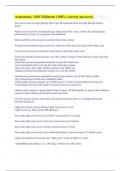
-
Astronomy 1010 Midterm (100% correct answers)
- Tentamen (uitwerkingen) • 24 pagina's • 2023
-
Ook in voordeelbundel
-
- $13.29
- + meer info
Star correct answers large glowing ball of gas that generates heat and light through nuclear fusion Planet correct answers a moderately large object that orbits a star, it shines by reflected light, planets may be rocky, icy or gaseous in composition Moon (satellite) correct answers an object that orbits a planet Asteroid (minor planet) correct answers a relatively small and rocky object that orbits a star Comet correct answers a relatively small and icy object that orbits a star ...
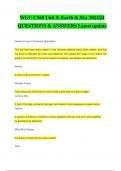
-
WGU C165 Unit 5: Earth & Sky 2023|24 QUESTIONS & ANSWERS Latest update
- Tentamen (uitwerkingen) • 14 pagina's • 2023
-
- $11.49
- + meer info
WGU C165 Unit 5: Earth & Sky 2023|24 QUESTIONS & ANSWERS Latest update Newton's Law of Universal Gravitation The law that says every object in the universe attracts every other object, and that the force is affected by mass and distance: the greater the mass of an object, the greater the attraction; the farther apart the objects, the weaker the attraction. Nebula a cloud of gas and dust in space Nuclear Fusion The process by which two or more small nuclei fuse to make a bigger nucleus...
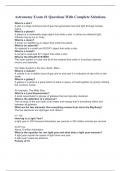
-
Astronomy Exam #1 Questions With Complete Solutions.
- Tentamen (uitwerkingen) • 10 pagina's • 2023
-
- $13.49
- + meer info
Astronomy Exam #1 Questions With Complete Solutions. What is a star? A star is a large luminous ball of gas that generates heat and light through nuclear fusion. What is a planet? A planet is a moderately large object that orbits a star. It shines by reflected light. Planets may be icy or rocky What is a moon? A moon (or satellite) is an object that orbits the planet. What is an asteroid? An asteroid is a small and ROCKY object that orbits a star. What is a comet? A comet is small a...
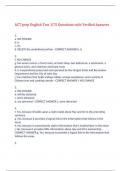
-
ACT prep English Test 1|75 Questions with Verified Answers,100% CORRECT
- Tentamen (uitwerkingen) • 15 pagina's • 2024
-
- $11.29
- + meer info
ACT prep English Test 1|75 Questions with Verified Answers 1. a. NO CHANGE b. is c. it's d. DELETE the underlined portion - CORRECT ANSWER b. is 2. f. NO CHANGE g. has seven rooms: a front room, an herb shop, two bedrooms, a stockroom, a general store, and a kitchen and bunk room h. is cooperatively preserved and operated by the Oregon Parks and Recreation Department and the City of John Day j. has a kitchen that holds antique tables, a large woodstove, and a variety of Chinese...
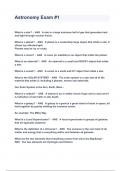
-
Astronomy Exam #1 Questions And Answers
- Tentamen (uitwerkingen) • 13 pagina's • 2023
- Ook in voordeelbundel
-
- $13.49
- + meer info
Astronomy Exam #1 Questions And Answers What is a star? - ANS A star is a large luminous ball of gas that generates heat and light through nuclear fusion. What is a planet? - ANS A planet is a moderately large object that orbits a star. It shines by reflected light. Planets may be icy or rocky What is a moon? - ANS A moon (or satellite) is an object that orbits the planet. What is an asteroid? - ANS An asteroid is a small and ROCKY object that orbits a star. What i...
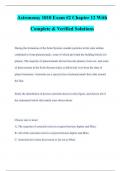
-
Astronomy 1010 Exam #2 Chapter 12 With Complete & Verified Solutions
- Tentamen (uitwerkingen) • 12 pagina's • 2023
-
- $11.48
- + meer info
During the formation of the Solar System, smaller particles in the solar nebula combined to form planetesimals, some of which provided the building blocks for planets. The majority of planetesimals did not become planets, however, and some of them remain in the Solar System today as debris left over from the time of planet formation. Asteroids are a special class of planetesimals that orbit around the Sun. Study the distribution of known asteroids shown in this figure, and choose all of t...
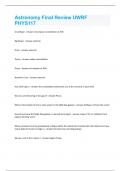
-
Astronomy Final Review UWRF PHYS117 Questions and Answers 100% Solved correctly
- Tentamen (uitwerkingen) • 12 pagina's • 2024
- Ook in voordeelbundel
-
- $7.99
- + meer info
Ursa Major - Answer-circumpolar constellation at 45N Big dipper - Answer-asterism Orion - Answer-asterism Taurus - Answer-zodiac constellation Draco - Answer-circumpolar at 45N Northern Cross - Answer-asterism Your birth sign is - Answer-the constellation behind the sun at the moment of your birth We are currently living in the age of - Answer-Pisces What is the location of of our solar system in the Milk Way galaxy? - Answer-Halfway out from the center How do we know the Milky Way gala...
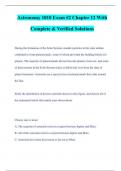
-
Astronomy 1010 Exam #2 Chapter 12 With Complete & Verified Solutions
- Tentamen (uitwerkingen) • 12 pagina's • 2023
-
Ook in voordeelbundel
-
- $9.49
- + meer info
Astronomy 1010 Exam #2 Chapter 12 With Complete & Verified Solutions During the formation of the Solar System, smaller particles in the solar nebula combined to form planetesimals, some of which provided the building blocks for planets. The majority of planetesimals did not become planets, however, and some of them remain in the Solar System today as debris left over from the time of planet formation. Asteroids are a special class of planetesimals that orbit around the Sun. Study the distribut...
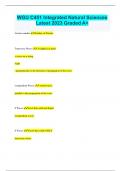
-
WGU C451 Integrated Natural Sciences Latest 2023 Graded A+
- Tentamen (uitwerkingen) • 21 pagina's • 2023
-
Ook in voordeelbundel
-
- $9.99
- + meer info
WGU C451 Integrated Natural Sciences Latest 2023 Graded A+ Atomic number Number of Protons Transverse Waves -A ripple in a pond -a wave on a string -light - perpendicular to the direction of propagation of the wave. Longitudinal Waves -sound waves parallel to the propagation of the wave P Waves travel thru solid and liquid Longitudinal waves S Waves Travel thru solids ONLY transverse waves Fission splitting of a large atom into two or more smaller ones. Fusion fusing of two or more lighter...
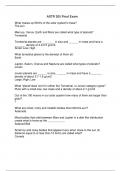
-
ASTR 205 Final Exam
- Tentamen (uitwerkingen) • 7 pagina's • 2023
-
Ook in voordeelbundel
-
- $10.00
- + meer info
What makes up 99.8% of the solar system's mass? The sun Mercury, Venus, Earth and Mars are called what type of planets? Terrestrial Terrestrial planets are ________ in size and ______ in mass and have a _______ density of 3.9-5.5 g/cm3 Small; Low; High What terrestrial planet is the densest of them all. Earth Jupiter, Saturn, Uranus and Neptune are called what types of planets? Jovian Jovian planets are ______ is size, ______ in mass and have a _______ density of about 0.7-1...



